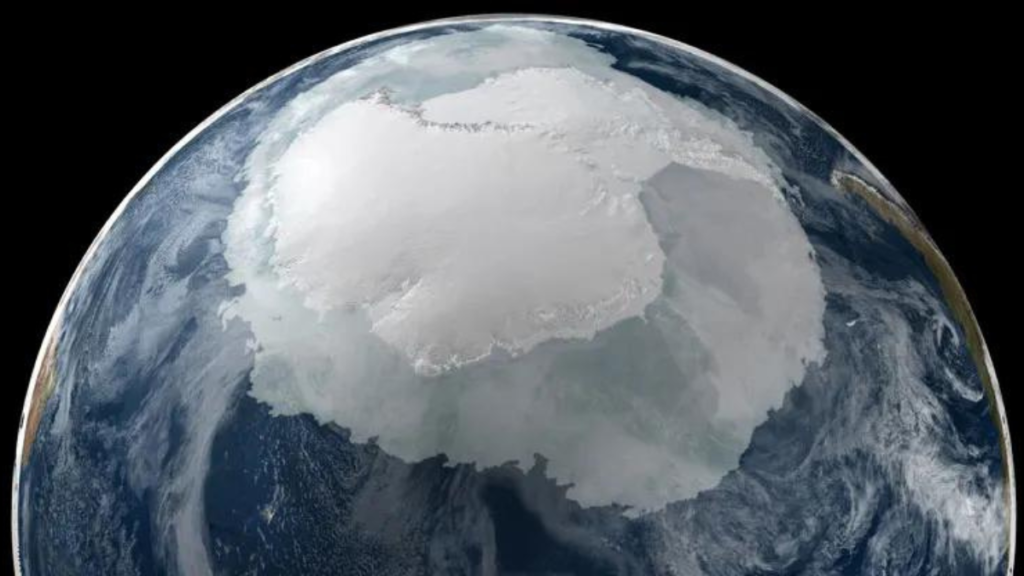Antarctica, the southernmost continent on Earth, is a mesmerizing landscape of stunning beauty and scientific importance. From space, it presents a vast, otherworldly canvas dominated by the Antarctic Ice Sheet, the largest single mass of ice on Earth. Satellite imagery captures the intricate patterns of glaciers, ice shelves, and sea ice that collectively shape the frozen landscape. The formation of icebergs breaking away from Antarctica’s ice shelves is a captivating feature visible from space, providing valuable insights into the dynamics of Antarctica’s ice masses and their contribution to sea level rise. The delicate dance of sunlight on the ice shelves also reveals their grandeur from space, highlighting their fragility. Beyond the frozen landscapes, Antarctica offers the celestial display, the Aurora Australis, or the Southern Lights, which are captured by satellite instruments equipped with specialized sensors, providing valuable data for researchers studying the Earth’s magnetosphere and its response to solar activity. However, the space-based observation of Antarctica highlights the fragility of this pristine environment and the urgency of global efforts to address environmental challenges.
The Frozen Tapestry:
From a spaceborne vantage point, Antarctica presents a vast, otherworldly canvas dominated by a seamless expanse of ice. The Antarctic Ice Sheet, the largest single mass of ice on Earth, is a breathtaking sight from space. Satellite imagery captures the intricate patterns of glaciers, ice shelves, and sea ice that collectively shape the frozen landscape. The visual spectacle of the ice sheet’s massive scale is a testament to the relentless forces of nature that have sculpted Antarctica over millennia.
Icebergs and Ice Shelves:
One of the most captivating features visible from space is the formation of icebergs breaking away from Antarctica’s ice shelves. These colossal masses of ice, some as large as cities, drift into the surrounding Southern Ocean. Satellite imagery allows scientists to monitor the movement and calving of icebergs, providing valuable insights into the dynamics of Antarctica’s ice masses and their contribution to sea level rise.
The ice shelves, massive floating extensions of the Antarctic Ice Sheet, also reveal their grandeur from space. The delicate dance of sunlight on the ice shelves creates a surreal spectacle, highlighting the fragility of these colossal structures. Scientists use satellite data to track changes in ice shelf thickness and study the potential impacts of climate change on their stability.
Aurora Australis:
Beyond the frozen landscapes, Antarctica offers a celestial display that captivates both scientists and space enthusiasts—the Aurora Australis, or the Southern Lights. From the unique perspective of space, these shimmering curtains of light paint the Antarctic sky with vibrant hues. Satellite instruments equipped with specialized sensors capture the intricate patterns of these auroras, providing valuable data for researchers studying the Earth’s magnetosphere and the interactions between solar particles and our planet’s atmosphere.
The mesmerizing dance of the Southern Lights serves as a reminder of the interconnectedness of Earth and the cosmos. It also underscores the importance of Antarctica as a natural laboratory for studying the Earth’s magnetic field and its response to solar activity.
Scientific Significance:
Antarctica’s remote and pristine environment makes it a crucial location for scientific research. From space, satellites equipped with various instruments enable scientists to monitor changes in the continent’s ice mass, track wildlife populations, and study atmospheric and climate patterns. The data collected from these observations contribute significantly to our understanding of global climate dynamics and help researchers assess the impact of climate change on Antarctica and beyond.
Moreover, the space-based perspective allows for the monitoring of ozone depletion over Antarctica, a phenomenon known as the ozone hole. This critical information aids in assessing the effectiveness of international efforts, such as the Montreal Protocol, in mitigating the depletion of the ozone layer.
Challenges and Conservation:
While the space-based observation of Antarctica provides invaluable insights, it also highlights the fragility of this pristine environment. Human activities, even in distant regions, can have far-reaching consequences. The visible impact of climate change on Antarctica, as observed from space, underscores the urgency of global efforts to address environmental challenges.
Conservation of Antarctica requires international cooperation and a commitment to sustainable practices. The space-based perspective serves as a powerful tool for raising awareness about the importance of preserving this unique ecosystem for future generations.
Conclusion:
Antarctica, when viewed from space, reveals itself as a mesmerizing blend of natural beauty, scientific curiosity, and environmental significance. The frozen expanses, the ballet of icebergs, the celestial light shows, and the scientific endeavors—all contribute to a narrative that extends far beyond the boundaries of the continent itself. As we continue to explore and study Antarctica from space, we gain a deeper appreciation for the delicate balance of our planet and the urgent need to protect its most remote and remarkable corners.







